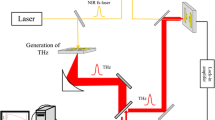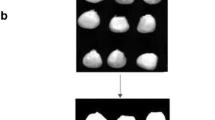Abstract
The fullness of rice seeds is an important factor affecting the growth and yield of rice. Therefore, it is of great significance to detect fullness of rice seeds in nature state. In this paper, the emerging terahertz imaging detection technology is used to carry out the study of rice seed fullness detection. Firstly, the terahertz spectral images of rice seeds with different fullness are acquired. Secondly, the terahertz spectra of sample free region, empty shell seed region, and full seed region are extracted, respectively. To improve the accuracy of the model and reduce the computational effort, competitive adaptive reweighting sampling (CARS), uninformative variable elimination (UVE), Successive projection algorithm (SPA), and their combination are used to extract the features of terahertz spectral information. The corresponding support vector machine (SVM) and K-nearest neighbor (KNN) qualitative discriminant models are established to detect and identify the full and empty regions of rice seeds. In addition, the binarization of terahertz image is carried out to realize the visual expression of rice seeds. The UVE-SPA-KNN model established after band screening is used for classification, and the accuracy of prediction set reaches 98.33%. The UVE-SPA feature extraction method can reduce the amount of imaging data by 97.5% and realizes the visualization detection of kernels in rice seeds. This research verified that the visual detection of seed kernel fullness inside rice seeds can be well achieved by using terahertz imaging and spectrum fusion, which provides a new method for rapid detection of kernel fullness of rice seeds, and also provides a theoretical reference for terahertz imaging technology to detect the fullness of other thin-shell seeds.
Highlights
-
1.
In this paper, three different spectra of different sample free region, empty shell seed region and full seed region in 0.5–3.0 THz image are extracted, and five band screening methods of CARS, UVE, SPA, CARS-SPA and UVE-SPA are used to extract the characteristic wavelength of the THz spectral.
-
2.
The discriminant model is established to distinguish between background region, empty shell seed region and full seed region. The research shows that the established UVE-SPA-KNN qualitative discriminant model has a recognition rate of up to 98.33%.
-
3.
The fullness of rice seeds is calculated by the ratio of binarization and shell-kernel pixel points of 0.5–3.0 THz images, the 150 threshold is used for shell in channel B, and the 235 threshold is used for kernel in channel R in the process of image binarization. The error between the detection fullness of rice seeds and the actual fullness is less than 10%.
-
4.
In order to reduce the amount of imaging data and remove redundant information, the UVE-SPA feature extraction method is further used to compress the full spectrum of 329 wavelengths into 8 wavelengths, which reduces the amount of imaging data by 97.5% and can also realize the visualization detection of kernels in rice seeds.











Similar content being viewed by others
Data Availability
Data underlying the results presented in this paper are not publicly available at this time but may be obtained from the authors upon reasonable request.
References
Karamysheva A V, Trofimuk L P, Priyatkin N S, et al. Microfocus X-ray radiography studies of seed fullness of Platycladus orientalis and Thuja sutchuenensis (Cupressaceae) for predicting seed sowing quality[J]. Rastitel'nye resursy, 2019, 55(4): 501-515.
Ali M A, Abdulateef M A, Mohammad A K, et al. Crop Seed Sizes and Their Role in The Productivity of Field Crops: A Review Article[J]. NTU Journal of Agriculture and Veterinary Science, 2022, 2(2):62-67.
Sivakumar V, Parthiban K T, Singh B G, et al. Variability in drupe characters and their relationship on seed germination in Teak (Tectona grandis L. f.)[J]. Silvae genetica, 2002, 51(5–6): 232–236.
Sun J, Zhang Y, Zhu X, et al. Deep learning optimization method for counting overlapping rice seeds[J]. Journal of Food Process Engineering, 2021, 44(9): e13787.
Škrubej U, Rozman Č, Stajnko D. Assessment of germination rate of the tomato seeds using image processing and machine learning[J]. European Journal of Horticultural Science, 2015, 80(2): 68-75.
Zhao G, Quan L, Li H, et al. Real-time recognition system of soybean seed full-surface defects based on deep learning[J]. Computers and Electronics in Agriculture, 2021, 187: 106230.
Wang Z, Fan S, Wu J, et al. Application of long-wave near infrared hyperspectral imaging for determination of moisture content of single maize seed[J]. Spectrochimica Acta Part A: Molecular and Biomolecular Spectroscopy, 2021, 254: 119666.
Wang Z, Tian X, Fan S, et al. Maturity determination of single maize seed by using near-infrared hyperspectral imaging coupled with comparative analysis of multiple classification models[J]. Infrared Physics & Technology, 2021, 112: 103596.
Musaev F, Priyatkin N, Potrakhov N, et al. Assessment of Brassicaceae Seeds Quality by X-ray Analysis[J]. Horticulturae,2022, 8(29):1-15..
Arkhopov M V, Potrakhov N N, Priyatkin N S, et al. Prospects of x-ray radiography in complex assessment of economic suitability of seeds[C]//AIP Conference Proceedings. AIP Publishing LLC, 2020, 2250(1): 020003.
Rong D, Xie L, Ying Y. Computer vision detection of foreign objects in walnuts using deep learning[J]. Computers and Electronics in Agriculture, 2019, 162: 1001-1010.
Hu J, Xu Z, Li M P, et al. Detection of Foreign-Body in Milk Powder Processing Based on Terahertz Imaging and Spectrum[J]. Journal of Infrared, Millimeter, and Terahertz Waves,2021, 42(8): 878-892.
Sun X, Liu J. Measurement of plumpness for intact sunflower seed using terahertz transmittance imaging[J]. Journal of Infrared, Millimeter, and Terahertz Waves, 2020, 41(3): 307-321.
Afsah-Hejri L, Akbari E, Toudeshki A, et al. Terahertz spectroscopy and imaging: A review on agricultural applications[J]. Computers and Electronics in Agriculture, 2020, 177: 105628.
Gente R, Busch S F, Stübling E M, et al. Quality control of sugar beet seeds with THz time-domain spectroscopy[J]. IEEE Transactions on Terahertz Science and Technology, 2016, 6(5): 754-756.
Yang S, Li C, Mei Y, et al. Discrimination of corn variety using Terahertz spectroscopy combined with chemometrics methods[J]. Spectrochimica Acta Part A: Molecular and Biomolecular Spectroscopy, 2021, 252: 119475.
Wei X, Li S, Zhu S, et al. Terahertz spectroscopy combined with data dimensionality reduction algorithms for quantitative analysis of protein content in soybeans[J]. Spectrochimica Acta Part A: Molecular and Biomolecular Spectroscopy, 2021, 253: 119571.
Kubiczek T, Balzer J C. Material Classification for Terahertz Images Based on Neural Networks[J]. IEEE Access, 2022, 10: 88667-88677.
Gong Z, Deng D, Sun X, et al. Non-destructive detection of moisture content for Ginkgo biloba fruit with terahertz spectrum and image: A preliminary study[J]. Infrared Physics & Technology, 2022, 120: 103997.
Scheller M, Jansen C, Koch M. Analyzing sub-100-μm samples with transmission terahertz time domain spectroscopy[J]. Optics Communications, 2009, 282(7): 1304-1306.
Fan W H, Burnett A, Upadhya P C, et al. Far-Infrared Spectroscopic Characterization of Explosives for Security Applications Using Broadband Terahertz Time-Domain Spectroscopy[J]. Applied Spectroscopy,2007, 61(6): 638-643.
Dorney T D, Baraniuk R G, Mittleman D M. Material parameter estimation with terahertz time-domain spectroscopy[J]. JOSA A, 2001, 18(7): 1562-1571.
Duvillaret L, Garet F, Coutaz J L. Highly precise determination of optical constants and sample thickness in terahertz time-domain spectroscopy[J]. Applied optics,1999, 38(2): 409-415.
Fastampa R, Pilozzi L, Missori M. Cancellation of Fabry-Perot interference effects in terahertz time-domain spectroscopy of optically thin samples[J]. Physical Review A, 2017, 95(6): 063831.
Li J, Zhang H, Zhan B, et al. Nondestructive firmness measurement of the multiple cultivars of pears by Vis-NIR spectroscopy coupled with multivariate calibration analysis and MC-UVE-SPA method[J]. Infrared Physics & Technology, 2020, 104: 103154.
Yang Y, Zhao C, Huang W, et al. Optimization and compensation of models on tomato soluble solids content assessment with online Vis/NIRS diffuse transmission system[J]. Infrared Physics & Technology, 2022, 121: 104050.
Tian X, Li J, Yi S, et al. Nondestructive determining the soluble solids content of citrus using near infrared transmittance technology combined with the variable selection algorithm[J]. Artificial Intelligence in Agriculture, 2020, 4: 48-57.
Liu C, Huang W, Yang G, et al. Determination of starch content in single kernel using near-infrared hyperspectral images from two sides of corn seeds[J]. Infrared Physics & Technology, 2020, 110: 103462.
Hassan M M, Jiao T, Ahmad W, et al. Cellulose paper-based SERS sensor for sensitive detection of 2, 4-D residue levels in tea coupled uninformative variable elimination-partial least squares[J]. Spectrochimica Acta Part A: Molecular and Biomolecular Spectroscopy, 2021, 248: 119198.
Yuan R, Liu G, He J, et al. Classification of Lingwu long jujube internal bruise over time based on visible near-infrared hyperspectral imaging combined with partial least squares-discriminant analysis[J]. Computers and Electronics in Agriculture, 2021, 182: 106043.
Li J, Luo W, Han L, et al. Two-wavelength image detection of early decayed oranges by coupling spectral classification with image processing[J]. Journal of Food Composition and Analysis, 2022: 104642.
Zhai Z, Jin Z, Li J, et al. Machine learning for detection of walnuts with shriveled kernels by fusing weight and image information[J]. Journal of Food Process Engineering, 2020, 43(12): e13562.
Xiong L, Yao Y. Study on an adaptive thermal comfort model with K-nearest-neighbors (KNN) algorithm[J]. Building and Environment, 2021, 202: 108026.
Zhao D, Hu X, Xiong S, et al. K-means clustering and Knn classification based on negative databases[J]. Applied Soft Computing, 2021, 110: 107732.
Henderi H, Wahyuningsih T, Rahwanto E. Comparison of Min-Max normalization and Z-Score Normalization in the K-nearest neighbor (kNN) Algorithm to Test the Accuracy of Types of Breast Cancer[J]. International Journal of Informatics and Information Systems, 2021, 4(1): 13-20.
Bardozzo F, De La Osa B, Horanská Ľ, et al. Sugeno integral generalization applied to improve adaptive image binarization[J]. Information Fusion, 2021, 68: 37-45.
Khairnar S, Thepade S D, Gite S. Effect of image binarization thresholds on breast cancer identification in mammography images using OTSU, Niblack, Burnsen, Thepade's SBTC[J]. Intelligent Systems with Applications, 2021, 10: 200046.
Bera S K, Ghosh S, Bhowmik S, et al. A non-parametric binarization method based on ensemble of clustering algorithms[J]. Multimedia Tools and Applications, 2021, 80(5): 7653-7673.
Zhang L, Li G, Sun M, et al. Kennard-Stone combined with least square support vector machine method for noncontact discriminating human blood species[J]. Infrared Physics & Technology, 2017, 86: 116-119.
Funding
The study was financially supported by National Key R&D Program of China: (2022YFD2001805), Jiangxi Provincial Youth Science Fund Project (No. 20224BAB215042), and Science and Technology Research Project of Jiangxi Education Department (GJJ210632).
Author information
Authors and Affiliations
Contributions
Conceptualization: Jun Hu and Haohao Lv. Methodology: Jun Hu, Haohao Lv, and Peng Qiao. Formal analysis and investigation: Jun Hu, Haohao Lv, and Peng Qiao. Writing—original draft preparation: Jun Hu and Haohao Lv. Writing—review and editing: Jun Hu, Haohao Lv, and Hongyang Shi. Funding acquisition: Yande Liu. Resources: Yande Liu and Yong He. Supervision: Yande Liu.
Corresponding author
Ethics declarations
Ethics Approval and Consent to Participate
Not applicable.
Conflict of Interest
The authors declare no competing interests.
Additional information
Publisher's Note
Springer Nature remains neutral with regard to jurisdictional claims in published maps and institutional affiliations.
Rights and permissions
Springer Nature or its licensor (e.g. a society or other partner) holds exclusive rights to this article under a publishing agreement with the author(s) or other rightsholder(s); author self-archiving of the accepted manuscript version of this article is solely governed by the terms of such publishing agreement and applicable law.
About this article
Cite this article
Hu, J., Lv, H., Qiao, P. et al. Research on Rice Seed Fullness Detection Method Based on Terahertz Imaging Technology and Feature Extraction Method. J Infrared Milli Terahz Waves 44, 407–429 (2023). https://doi.org/10.1007/s10762-023-00922-5
Received:
Accepted:
Published:
Issue Date:
DOI: https://doi.org/10.1007/s10762-023-00922-5




